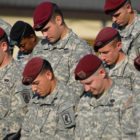
After six years away, the Cuba correspondent for the Associated Press, Anita Snow, recently returned to Havana to find a different atmosphere under the regime of Raul Castro, the brother of longtime but ailing leader Fidel Castro and President Obama’s partner in opening up diplomatic relations between the U.S. and Cuba. Retelling the process of taking her luggage through customs loaded with electronic gear and clothing for friends, Snow described the huge change from years ago, as customs agents declined to rummage through her bags but simply gave her a friendly greeting and a pass.
“It was the first sign of the more relaxed and hopeful atmosphere I found during a brief visit back to Havana this month, a feeling that didn’t exist during my 1999-2009 tenure,” Snow writes. “The differences I saw and felt made me realize how much my decade in Cuba had been characterized by anxiety and isolation, and what a different country it is becoming under President Raul Castro’s modest reforms.”
For Americans reacting to President Obama’s December 17th announcement of plans for normalization with Cuba, the hunger for interaction and exchange is palpable. People are champing at the bit to visit, to explore, and to invest. Snow suggests that Cubans might be feeling similarly: “Everywhere I traveled around Havana, hopes were high for more change after Cuba and the U.S. announcement on Dec. 17th. Cubans seem especially keen for more visits by Americans.”
After decades of isolation, some of it self-imposed, much of its mandated by the counterproductive American embargo, the doors of Cuba are flinging open, with nonprofits and social enterprises within the crowds of people who hope to rediscover the island 90 miles away from Key West. Both sides, Cubans and Americans, might be well advised to take it slowly, suggests Eric Leenson, president of SOL² Economics.
Leenson addressed a gathering of foundations and nonprofits to talk about conditions in Cuba and what might be expected as the dynamic that awaits business investors, particularly those committed to social and environmental responsibility. With the participation of the Christopher Reynolds Foundation, Leenson started the Socially Responsible Enterprise and Local Development in Cuba Project with a mission “to understand and assist Cuba’s efforts to preserve the social achievements of the Revolution while creating a prosperous and sustainable economy.”
Visiting Cuba regularly, Leenson’s focus seems to be on tapping building connections for and among social enterprises within Cuba and between Cuba and other nations. For the purpose of his presentation at the Washington Office on Latin America, Leenson spoke mainly about his extensive interactions with cooperatives in Cuba and drew on his study trip last year in the company of representatives of the National Cooperative Business Association and other proponents of “new economy” forms of business endeavor.
Sign up for our free newsletters
Subscribe to NPQ's newsletters to have our top stories delivered directly to your inbox.
By signing up, you agree to our privacy policy and terms of use, and to receive messages from NPQ and our partners.
While everyone is celebrating President Obama’s surprise normalization announcement, Leenson suggests that not much has actually changed on the ground since the announcement. Some of the initiatives that President Obama has proposed haven’t yet gotten formal responses from his Cuban counterparts, Leenson says. Compared to White’s observations, Leenson described Cubans as a little suspicious of what might be coming down the pike. It’s certainly understandable. In the past few years, for example, Cuba has endured the USAID-funded “ZunZuneo” program, carried out by a USAID for-profit contractor, engaged in recruiting young people as part of a regime change effort. Leenson said that his organization’s efforts in connecting Cuban and non-Cuban social enterprises became more difficult as of last May or so, potentially when the background negotiations between the U.S and Cuba became intense.
The diplomatic opening has both sides approaching each other gingerly, looking to achieve certain things from the diplomatic opening but wanting to protect their own interests. That fits the observation of Cuba expert Carla Anne Robbins, who said in a program in January at the Council on Foreign Relations that “President Obama hopes to use the detente to bring Cuba into the twenty-first century and move it toward democracy, whereas the Cubans’ objective is to gain the maximum financial gain while maintaining ‘as much of the Old Castro system as they can.’” The financial benefits Cuba seeks are some $2.5 billion in annual foreign investment for maintaining or, perhaps more accurately, creating a sustainable economy. In recent years, Cuba has loosened some of the restrictions on its economy, allowing more state enterprises to restructure themselves as independent cooperatives, giving more autonomy to somewhat decentralized state enterprises that remain under governmental control, and reducing the proportion of the Cuban population that is employed by the state from nearly 95 percent down to 50 percent. But Leenson notes that the government doesn’t intend to undo its control of the most important means of production in the economy.
As a result, the shift of part of the economy to independent cooperatives has been slow, though speeding up in the past year or two as control of the country shifts more clearly to Fidel’s brother, Raul Castro. Leenson reports that as of the end of 2014, there were around 5,500 cooperatives in Cuba, all but about 345 agricultural. Agricultural cooperatives have existed in Cuba since 1961, but the pace of converting non-agricultural state enterprises to cooperatives has been increasing in some areas of the economy, particularly in service industries like restaurants, food supplies (groceries), and personal services (for example, taxi services). As important as it might be for Cuba to reduce the extent of the state’s control of the economy, Leenson says that it is very difficult to get approval for cooperatives due to the Cuban bureaucracy, despite a recent statement from a Cuban government official that they hoped to create 10,000 cooperatives during the next two years.
The picture that Leenson describes is a nation that is moving both quickly and slowly, concerned about protecting some aspects of its society from outside influences while knowing that it has to make significant changes in order to survive and grow. Opening Cuba to outside influence, foreign investment, and private enterprise has revealed fissures in Cuban society, inequities in housing and services, often shown in differences between black and white Cubans. Cubans with family members in the U.S. sending remittances live better and have access to better services than most others; white Cubans are 2.5 times more likely than black Cubans to such receive remittances, valued at between $1 billion and $3 billion a year. Randal Archibald in the New York Times describes “the predominance of white Cubans in the new ventures…[and] also the hard economic times that darker-skinned Cubans continue to endure.”
Leenson and others believe that there is much that the U.S. can learn from Cuba—not only about cooperatives, but in other areas as well, particularly healthcare. Long before the recent diplomatic opening, the nonprofit Medical Education Cooperation with Cuba (MEDICC) has been running exchanges between U.S. and Cuban healthcare professionals. Last month, a MEDICC trip included members of Grantmakers in Health, with particular attention to the Cuban system of neighborhood consultorios, local teams of doctors and nurses focused on community outreach. Representatives of the E.F. Schumacher Center, such as Greg Watson and Susan Witt, believe that there is much Americans can learn from Cuban agriculture, which in some ways has been an avatar of new economics by having to operate without access to much of the petroleum-based agricultural techniques that characterize modern agriculture.
Nonetheless, the exchanges on both sides will proceed a little more slowly than some might expect. The second round of negotiations between the U.S. and Cuba starts Friday with major hurdles to be addressed, particularly the U.S. retention for the moment of Cuba on the list of state sponsors of terrorism. Cuba’s designation as a sponsor of terrorism makes banks wary about providing banking services on the island. Not yet on the agenda, but unavoidable for the Cubans, will be negotiations about human rights. Last week, it appears that Cuba arrested between 100 and 200 dissidents across the country, including members of Ladies in White during one of their regular marches through Havana. In recent months, other protests, small or large, have been greeted with government detentions and arrests, including the effort of one artist, Tania Bruguera, to set up an open mic for Cubans to say whatever they wanted to say about politics.
Even as the process of restoring diplomatic relations creaks along—and the embargo stays in place, until Congress makes the necessary changes—the enthusiasts in the U.S. for tapping into distinctly Cuban resources will be hard to contain. With loosened travel restrictions, Americans will be coming to Cuba for a multiplicity of non-tourism reasons, even with the embargo still in effect, and returning with as much tobacco in the form of cigars as they can take through customs (legally, $100 maximum), joining the people from scores of other countries who show up in Havana for the nation’s annual cigar festival. For those who are not cigar-smokers, the invasion of Cuba by Major League Baseball teams has already started, with the Red Sox signing 19-year-old switch-hitting infielder Yoan Moncada for $31.5 million (and paying an equal amount as a penalty for having pierced professional baseball’s international spending cap). The other sector likely to burst at the seams due to the attractiveness of Cuba is the cruise ship industry, giving travelers a new Caribbean cruise destination.
U.S. nonprofits will be well represented in the flock of new people and institutions coming to Cuba. Among the 12 general licenses for travel to Cuba that the U.S. is now freely allowing as reasons (other than tourism) are professional research and professional meetings, humanitarian projects, efforts of private foundations, educational activities, and religious activities, all of which will involve U.S. nonprofits in one way or another. In the White House’s December 17th announcement, there was the intention of building and strengthening civil society in Cuba and encouraging democratic reforms. While the Cuban government knows it needs to engage in economic reforms and attract foreign investment, it certainly can read the December 17th statement as geared toward weakening the authority of the central government, particularly in this statement: “The U.S. efforts are aimed at promoting the independence of the Cuban people so they do not need to rely on the Cuban state.” It would be inaccurate and naive for U.S. nonprofits and foundations to simply assume that the start of diplomatic negotiations means that the island is ready for the shock therapy of a rapid opening and shift to a radically new economic and political system.
Leenson’s advice to U.S. nonprofits and foundations seems sober and pragmatic. Expect bureaucratic obstacles on the Cuban side. Try to make sure that the interventions and assistance that you might be motivated to offer really meets the interests and priorities of Cubans. Don’t slip into regime change thinking (as the USAID support for the ZunZuneo program demonstrated), which will spark unproductive suspicions—and probably even more bureaucratic obstacles. From our perspective, we would suggest that rather than falling into political traps, U.S. nonprofits and foundations can propose and pursue projects and initiatives that address the mutual interests of both countries: environmental protections (particularly in connection to climate change and global warming), artistic and cultural exchanges, joining forces against drug trafficking and human trafficking, supporting cooperatives and other sanctioned democratic expansions of the Cuban economy, increasing opportunities for bringing electronic and communications gear to Cuba, and continuing, facilitating learning, and expanding exchanges between American and Cuban legislators, teachers, and medical personnel.—Rick Cohen












